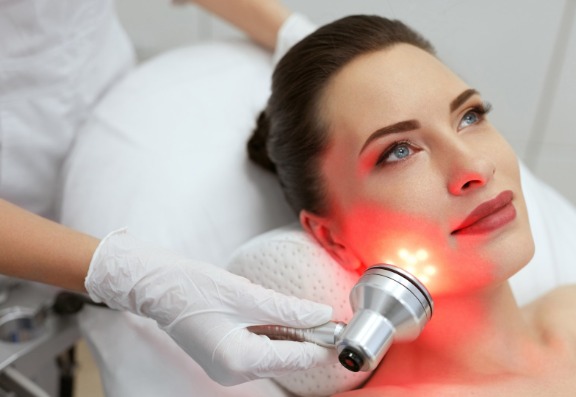Red Light Therapy (Rlt) Uses a Specific Natural Wavelength of Light (630-660nm) For Therapeutic Benefits Which Are Both Medical and Cosmetic.
Light can penetrate the top layers of our skin and directly influence the functions of the cells there, increasing the production of collagen and elastin.
It increases the supply of oxygen to the skin as well as improves circulation.
All these processes serve to repair damaged tissue and thus improve the skin’s texture as well as enhance wound healing.
Red light can also decrease inflammation and bacteria as well as help to treat pre-cancerous lesions.
It's important to note that this particular light wavelength is different to the UV rays from the sun or tanning beds, and there is no increased risk of cancer or UV damage.

So, specifically, red light therapy can be used in the following ways:
So, in summary, when your skin cells are hit with the correct red light wavelengths, a host of regenerative effects occur, leading to potential benefits which include a clearer, calmer complexion, younger-looking skin and diminished scarring.
If you want to read more, the experts at Consulting Room really know what they're talking about and have put together Scarring, Acne, light treatment, Rosacea, Chemical peel, Lines and wrinkles, Microneedling, Texture and complexion improvement FAQs just for you.
If you have more questions, you can use the Scarring, Acne, light treatment, Rosacea, Chemical peel, Lines and wrinkles, Microneedling, Texture and complexion improvement questions feature to talk to our panel of trained medical experts.
If you're keen to get started with any of these treatments right away then you're in luck - those clever folks also have a list of trusted, accredited Scarring, Acne, light treatment, Rosacea, Chemical peel, Lines and wrinkles, Microneedling, Texture and complexion improvement clinics in your area.
Many thanks to the author of this blog Dr Sam Robson who owns Temple medical in Aberdeen.
Dr Sam Robson is a highly respected and experienced practitioner who qualified as a GP in 1997 and has been practising aesthetic medicine since 2004.
She has also become progressively aware of the increasing incidence of low morale and self-esteem
The repertoire of treatments provided by the clinic aims to help address many problems.
Call Dr Sam Robson on 0122 486 9997 or visit www.templeclinic.co.uk.

Here we’ll guide you through how to identify its triggers and what you can do to prevent it.
Did you know that happy guts = happy skin?
Did you know your gut health can affect your skin? Our latest blog dives into the fascinating connection between digestion and skin wellness — exploring how a healthy gut can support clearer, more radiant skin.
Hey, wait!
Before you go.....
Let's stay in touch, pop your details here and we'll send our editor's hand-picked updates on your fave subjects.